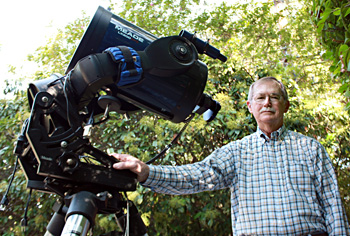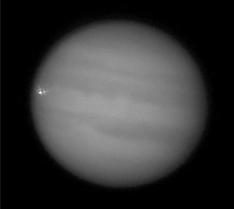On Sept. 10, UT Dallas student and amateur astronomer George Hall awoke at 5 a.m. to set up his telescope in his back yard. With clear skies and his telescope fitted with a video camera, he had hoped to spend the time before sunrise capturing a series of videos of the planet Jupiter, which was directly overhead.

George Hall is a retired engineer and Dallas resident who takes classes at UT Dallas, including astronomy and geosciences.
By the end of the day, a snippet of his Jupiter video would be internationally famous.
Hall may have been the only person in the world to capture video of an apparent object hitting the planet Jupiter on that date. The impact created a bright fireball on the planet that lasted only a few seconds, but catching the event resulted in several hours of fame for the unassuming Hall.
“The last thing I expected was for a historical event to happen in my back yard,” said Hall, a retired engineer and Dallas resident who takes occasional classes at UT Dallas, including astronomy and geosciences. He’s currently enrolled in a special topics class in astrophysics taught by associate professor of physics Dr. Lindsay King.
Hall posted a four-second video clip of the Jupiter impact to Flickr, and overnight, the site received more than one million visitors. His website had about 50,000 hits, he said.

A bright spot on the left side of this video shows the impact of an object on Jupiter captured earlier this month by George Hall. (Viewing the video may require Flash.)
Hall has had requests for his video from personnel at NASA, the Jet Propulsion Laboratory and the SETI Institute. Dozens of news agencies from around the globe have interviewed him or requested permission to post his video.
The apparent object impact on Jupiter was first observed visually at about 6:35 a.m. Sept. 10 by Dan Petersen, an amateur astronomer in Wisconsin, who relayed his observation to an online astronomy forum. Hall saw that post at about 5 p.m. and went back to check the raw footage he had taken that morning.
Had it not been for Petersen’s post, Hall said he might never have known he had captured the moment of impact for posterity and science. Here’s why:
The camera attached to Hall’s telescope can take digital photos of Jupiter at 30 frames per second, and he takes about 2 minutes of video at a time. But even during the clearest observing conditions, fluctuations in the atmosphere can result in some of the frames being sharp and others blurry. Hall uses special software that automatically selects the clearest frames from the raw data and combines them to form a detailed image, while discarding the blurriest frames.
“I would never have seen the impact had Dan not seen it first and posted his email, which alerted me to go back and look at my raw footage,” Hall said. “It was just happenstance that it all came together.”
“The last thing I expected was for a historical event to happen in my back yard.”
George Hall,
retired engineer and UT Dallas student
Hall’s reaction when he saw the impact on his own video?
“Elated, excited, jaw-dropping,” he said.
UT Dallas’ Department of Physics hosts a web page where Hall provides technical information about his video capture for scientists and astronomy enthusiasts, including the equipment and techniques he used and a very large file containing about 2 minutes of the raw video of Jupiter. The impact can be seen as a bright flash about halfway through the footage.
Hall will give brief remarks about his Jupiter video at a Friday, Sept. 28, meeting of the Texas Astronomical Society of Dallas. The meeting, which is free and open to the public, will begin at 7:30 p.m. in the Kusch Auditorium in the Founders North Building on the UT Dallas campus.